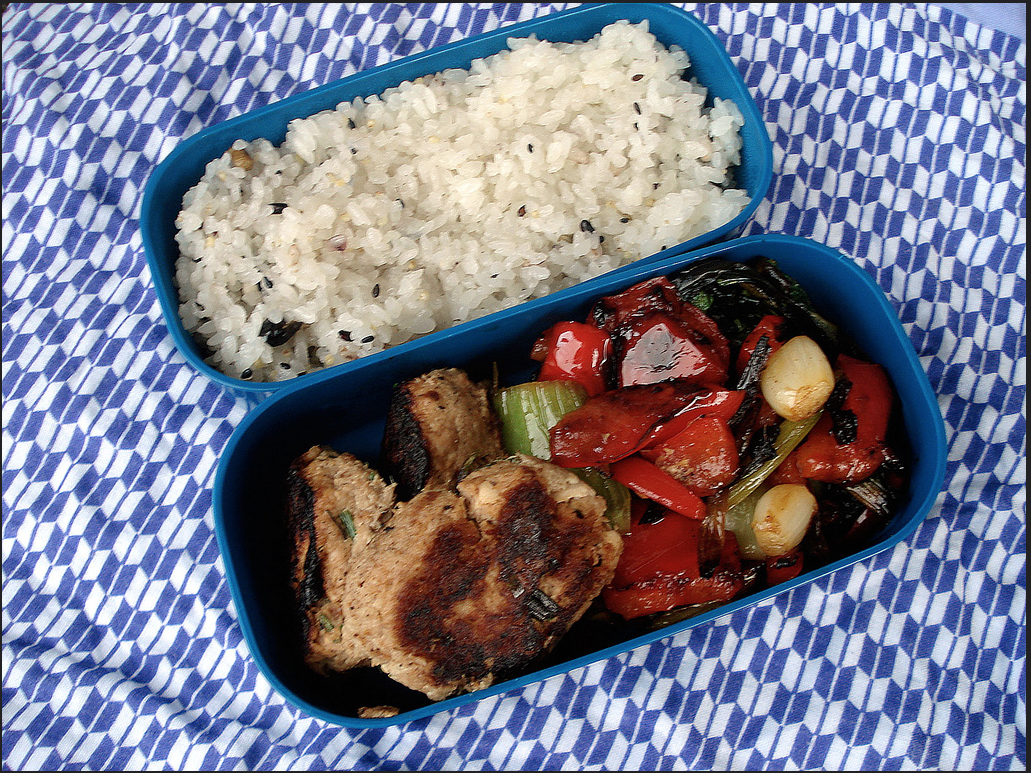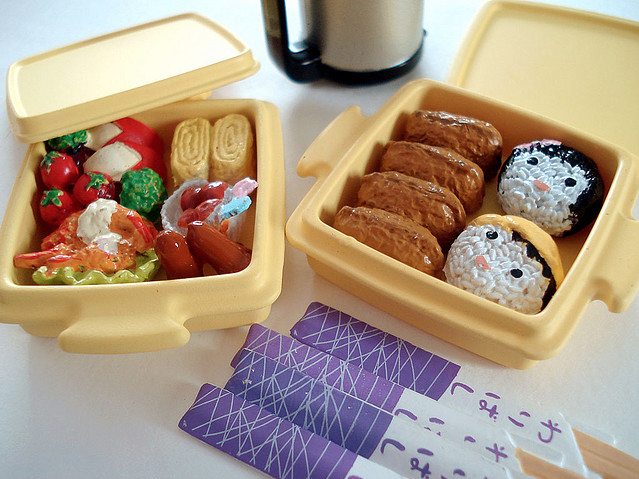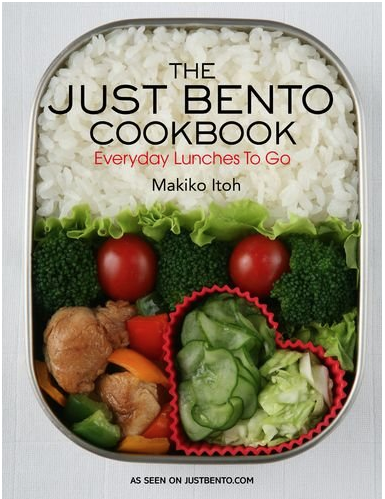Exploring Japanese Cooking with Makiko Itoh
Being able to explore international cuisines is one of the most interesting parts of the food world! It is a pleasure for The Culinary Exchange to be able to speak with with food experts all over the world and introduce them to our readers. On this post, we explore Japanese cooking with Makiko Ito. Makiko is the author of The Just Bento Cookbook. She blogs at JustBento.com and JustHungry.com.
1. Why is Japanese food or Japanese cooking so popular?
I am not sure that it is that popular overall (if you are talking about the U.S. primarily). It is getting there, but at the moment only a small number of dishes are popular: sushi of course, ramen, and a few other things such as Japanese style curry. There are Japanese-inspired things like bottled teriyaki sauce, but that is a bit different. It is not as popular as other Asian cuisines yet, probably, if you just count the number of restaurants and so on. But hopefully it’s getting there! A lot of the basic concepts of Japanese cuisine are very modern, such as an obsession with the seasonality and provenance of the ingredients used. In the west most people only know about, or are concerned about, the seasonality of fruits and vegetables, but in Japan fish has seasons too.
2. What would you consider the defining dish of Japanese cooking and why?
Plain steamed rice and miso soup. The quality and taste of rice is extremely important in Japanese cuisine. Miso soup contains the fundamental flavor base of most savory dishes, dashi – a stock made with a combination of dried seaweed and fish (dashi actually means ‘stock’ in Japanese), plus one of the many fermented products used in cooking, miso.
3. What is the one ingredient in Japanese cooking that you couldn’t live without?
Good rice, for the above reason.
4. What is the most interesting Japanese fusion dish that you’ve ever created?
I am not sure if it’s the most interesting, but I’ve recently been making okonomiyaki (a kind of savory pancake) with zucchini instead of cabbage, because cabbage is just not in season in the summer. It’s pretty good. (Recipe to be posted soonish)
5. What is a common misconception that people have about Japanese cooking?
That it’s all ‘healthy’. This probably has something to do with the fact that of all the so-called developed nations, Japan has by far the lowest rates of obesity. But that has more to do with societal issues. The cuisine itself does tend to be vegetable-centric to an extent, but there are a lot of dishes that are delicious, but aren’t necessarily ‘healthy’. It all depends on the amounts you eat.
6. If you could tell people 1 thing about Japanese cooking, what would it be?
You need good rice, and good dashi. Add good soy sauce and miso, and from there you can create ‘authentic’ tasting Japanese cuisine, even if you cannot get a hold of a lot of other ingredients.
7. What are some less thought of herbs or spices that you should always have handy when cooking Japanese cooking?
Again, I don’t think people realize how important dashi is. Ideally you want to stock dried kombu (a type of seaweed – not related to ‘kombucha’ in any way) and katsuobushi (fermented and dried bonito or skipjack tuna that is usually sold as thin flakes). I know these are not herbs or spices, but they are really important to have.
There really aren’t any ‘must have’ herbs or spices in Japanese cuisine, since they are used as garnish and flavor enhancers usually rather than as a base (unlike in say, many South Asian cuisines). If you can’t get kombu or katsuobushi though, there are decent dashi stock granules available these days.
8. What would you tell someone interested in starting to cook Japanese cuisine at home. What dish do you think they should start with?
I’m being repetitive, but learning to cook rice properly (with the right kind of rice) is very important, as is making a good dashi to make miso and other types of soup, simmer vegetables in, and more. I did a Japanese Cooking 101 series a couple of years ago on my site (starts here: http://justhungry.com/announcing-japanese-cooking-101-fundamentals-washoku ) which explains how to make both, plus other things which are basic to traditional Japanese cuisine such as simmered vegetables, breaking down fish, etc.
9. We have seen more references to Kaiseki cuisine lately. What is is it and what makes it so special?
Kaiseki is a multi-course meal that started out as a meal served at tea ceremonies, although these days it’s not restricted to tea ceremonies and you don’t have to have tea with it. It has probably become well known because in many ways it is the pinnacle of fine dining in the traditional manner, and it’s something that people from the West can relate to in terms of its multi-course nature (like multi-course French menus).
It has all the features of Japanese cuisine like attention to seasonality, fine knife work, beautiful presentation, etc. It’s also accessible in that it’s served at restaurants (expensive ones). It also originated in Kyoto, which has been a tourist mecca for hundreds of years, and is the one place probably most tourists from overseas want to visit.
“Tasting menus” in other types of fine-dining restaurants are probably influenced at least partially by kaiseki meals.
I should mention though that serving small amounts of different dishes is a basic way that Japanese food is presented, even at home. And kaiseki restaurants are not the only place you can enjoy that kind of eating. The overall term for high end multi-course, multi-dish cuisine of this type is Kappo, so if someone takes you to a “kappo” restaurant they are treating you to something special. (Also there are two types of meals that are both called ‘kaiseki’…but the description I gave is for the one that’s known in the West. Both are Kappo type meals though.)
10. You have written a book about Bento Boxes – The Just Bento Cookbook. What was your inspiration for the book and what was the most fun part of writing it? Can you give us some insight about what a bento box is and what makes a great bento box?
A bento is a meal packed in a box. The type of bento I write about is the homemade lunch bento. I started JustBento.com because I wanted to tell people how to pack their own bentos, which can be a great way to eat healthier, save money, and have fun too. I have a post here – http://justbento.com/handbook/bento-culture/japanese-life-bento which explains the role various bentos play (homemade and other types) in the life of a Japanese person.
11. Is there a dish from way back that you dream about? Who made it for you and can you make it the same way?
It’s not a meal actually, but it’s bread, a baguette to be exact…made at a little bakery in a village called Monsegur sur Lauzon in Provence, France. It was the best baguette I’ve ever had. Unfortunately the baker suddenly sold his store some years ago – I don’t know why. I have tried many other baguettes since at many bakeries, but that was still the best baguette ever. I’m not a good enough baker to recreate it…and I still miss it.
12. Who is your favorite chef or cook? Why?
Teachers and cookbook authors: Julia Child, Katsuyo Kobayashi. Both were great on TV, showing how to cook food that tasted delicious, and both also wrote wonderful cookbooks. They were also very funny ladies both. (American fans of Iron Chef (the original series) may remember Katsuyo Kobayashi from “Battle Potato” but she was a prolific and very popular TV presenter and cookbook author.) Professional chefs: Pierre Hermé is an artist and a genius. But I do dislike the current tendency to make even mediocre chefs ‘rock stars’.
13. What is the best meal you have had in the past month? What made it great?
I made gazpacho, using juicy, seasonal, local tomatoes, and it was fantastic for that reason.
The Just Bento Cookbook is available for sale on Amazon.com.
More of Makiko’s cooking and writing can be found at JustBento.com and JustHungry.com.
Makiko can also be found on Facebook, Twitter, Pinterest, Instagram, and Flickr.
I hope you enjoy!
Keep Eating! Keep Innovating!
What is your favorite Japanese food? Have you visited Makiko’s websites or read her book?Let us know all about it in the comments or on Facebook.
The Culinary Exchange can also be found on Twitter, Instagram, Pinterest, Google+ and YouTube.
Come On! Follow Along!












Trackbacks/Pingbacks